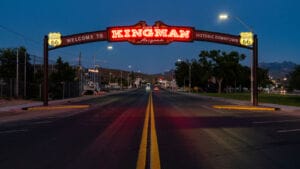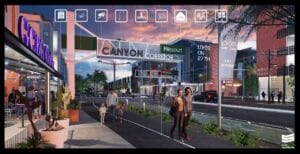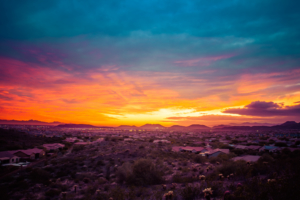Arizona’s Retail Industry, Retail Centers Top Economic Driver
The world of retail has come a long way since Arizona’s first shopping center, Park Central Mall, opened in 1957. Back then, the state was known mostly for cowboys, cactus and critters.
How times have changed.
Arizona’s retail industry is now one of the state’s top economic drivers, as spectacular shopping centers have sprung up from the desert floor over the years.
The History of Arizona’s Shopping and Retail Centers
Built in 1961, trendy Scottsdale Fashion Square is Arizona’s largest retail center at 2 MSF. The Westcor-developed mall is home to high-end retailers such as Barneys New York, Nordstrom, Gucci and Neiman Marcus.
To appreciate the history of retail in Arizona, however, one simply needs to return to its roots: Park Central Mall.
Located on Central Avenue in midtown Phoenix, Park Central Mall originally was anchored by Goldwater’s, Diamond’s and a “five-and-dime” store. It was an open-air facility that helped put Arizona on the real restate map. It served as the first stepping stone to Arizona’s long history of retail. The next two major projects — Christown Mall and Metro Center — also are key milestones on that timeline. Rick Hearn, director of leasing at Vestar Development Company, recognizes their historical importance.
“Christown, Metro Center, Park Central — what was happening in Arizona was also happening around the country. We were in step with the rest of the world,” Hearn says.
Christown, now known as Phoenix Spectrum Mall, was Arizona’s third shopping center. As the state’s first closed center, it also was one of the first air-conditioned malls in the Western United States.
According to Stan Sanchez, president and partner of De Rito Partners, much of Christown’s appeal and success were a result of the surrounding mixed-use amenities. There were multiple components including hotels, auto malls and other retail stores. These elements enhanced Christown’s viability in particular, and Arizona retail in general.
Metro Center, at 1.39 MSF, is Arizona’s second largest retail center. When it opened in October 1973, it was considered one of the largest malls in the country. With two levels and a series of popular anchors, Metro Center set a great precedent for later retails projects in Arizona and the U.S.
According to Hearn, Metro Center was a step away from the typical “mom-and-pop centers,” but certainly a step in the right direction. It wasn’t just a retail center; it was a commercial location as well, building on the mixed-use components for which Christown had previously become famous.
Malls such as Metro Center catered to typical shoppers and enabled them to purchase multiple, everyday needs in one easy trip.
“As (retail) developers we really have to cater to the retailers,” says Jim Pederson, chairman of The Pederson Group. Pederson, along with other real estate developers, also made it a point to identify the needs of the consumers.
Metro Center was a stepping stone to the next level for Arizona, De Rito’s Sanchez says. And that next level would be achieved with each additional project after Metro Center. Scottsdale Pavilions, recently renamed The Pavilions at Talking Stick, was built in 1989. It was one of the first retail centers built on Native American land in Arizona.
Today it’s a 1.1 MSF open-air “power center” with retailers such as Sports Authority, Target, Home Depot and Walmart. According to Chuck Carlise, president of De Rito Partners, the strongest anchors for shopping centers are grocery stores. As the “bread and butter” of De Rito and other developers, grocery stores have proven to be a very successful format for retail.
But more goes into building a successful retail center in Arizona than just anchor stores, especially in the unavoidable heat of the desert. In the middle of summer, shoppers need a place to go and a place to eat that will shelter them from the blistering sun. With retail centers such as Mesa Riverview and Tempe Marketplace, there is the option to shop, eat or play inside and out.
“It’s important to withstand the extreme temperatures while still taking care of the people’s needs” Pederson says.
Mesa Riverview, a De Rito development that opened in 2007, targets a broad audience and all aspects of the consumer with office buildings, auto malls, retail stores and other commercial businesses. From a trendsetter’s standpoint, Hearn of Vestar understands the need for people to avoid the heat and the need to design projects that can keep them cool and happy.
Part of what keeps shoppers happy is the lifestyle component of destinations such as Kierland Commons and Scottsdale Quarters, which include residences, hospitality, entertainment, office and retail.
Designed in 1997 to be the first urban village to integrate mixed-use with outdoor shopping, Kierland Commons (on the Phoenix-Scottsdale border) opened in 2000 and has served as a benchmark for similar mixed-use projects around the nation.
“If you were able to take a look from a satellite view, it was really the evolution of the communities that led to the method the developers used to custom tailor the development to Arizona’s lifestyle and how they wanted to live” Sanchez explains.
CityScape in Downtown Phoenix is another example of how Arizona retail has evolved. As Phoenix grew, CityScape, a mixed-use skyscraper, became a part of the downtown skyline. Part of the appeal, according to Hearn, is the downtown office, urban feel that CityScape provides. It’s unique to the area, but gives Phoenix a great deal of character. The only aspects missing are quality residential developments.
Despite the recession and record-high vacancy rates in Arizona’s retail sector, there is hope for the future.
“Phoenix has always rebounded,” Hearn says. “We’re in the top 11 states for job growth and for relocation. We have a quality of life that no one else has.”
That quality of life is evident at such retail projects as Scottsdale Fashion Square, Chandler Fashion Square and San Tan Village in Gilbert
From its start in 1957, Arizona retail has grown into a formidable industry across the state. With mixed-use, open air and luxury options, shoppers have every aspect of retail at their fingertips.
“The beauty of how Arizona’s retail has evolved is the fact it created your Saturday mid-day experience,” Sanchez says. “Arizona developers have given the public all they need for every day of the week.”



